The Best Things To Do in Lisbon
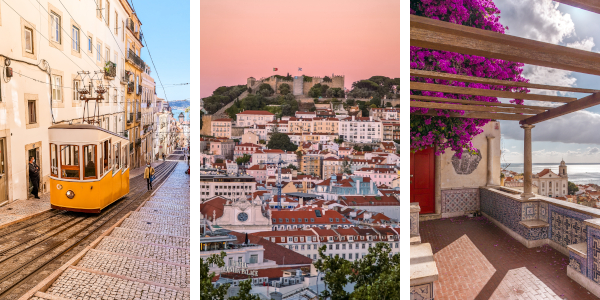
A 4-Day Sightseeing Guide
Lisbon, the capital of Portugal, is a vibrant city that attracts millions of visitors every year. With its rich history and stunning architecture, Lisbon offers plenty of things to do. From exploring the narrow streets of the Alfama neighborhood and taking in panoramic views of the city from the many miradouros (viewpoints) to visiting iconic landmarks such as Castelo de São Jorge and indulging in the famous pastéis de nata, you won’t get bored in Lisbon. The city is also closely located to the historical town of Sintra, which is filled with the most beautiful estates and palaces, as well as Cascais, the scenic coastal town. Both Sintra and Cascais are perfect to visit on a day trip from Lisbon. In this blog post, we’ll take a closer look at some of the best things to do in Lisbon and share our 4-day itinerary with you, so you can make the most out of your trip to the Portuguese capital.
Day 1
After driving 3 hours from Porto, we arrived in Lisbon in the afternoon. On our arrival day, we took it slow while visiting some viewpoints and strolling through the Alfama neighborhood at the end of the afternoon.
Miradouro do Graça
Miradouro do Graça is a viewpoint located in the Graça neighborhood. When we were there last year, there were constructions going on, obstructing a part of the view. The views were still beautiful, but when taking photos, you had to frame it just right to keep the cranes out of your shot. Because of the constructions, it also didn’t feel like a place where you’d like to spend some time enjoying the views. As we were in Lisbon a year ago, we assume the constructions are done now. There’s also a bar with a large outdoor seating on the square of the viewpoint. It’s a 20-minute walk from Praço do Comércio. Be aware you have to climb quite a few stairs to get here as it’s pretty high up. There are no stairs if you walk through the Alfama neighborhood, just inclined roads.

Miradouro do Graça
Alfama neighborhood
Alfama is the oldest neighborhood in Lisbon. The name Alfama is derived from the Arabic “al-hamma”, which means “hot fountains” or “baths”, similar to “hammam”. During the Moorish rule, the Alfama neighborhood actually was the entire city of Lisbon. The neighborhood consists of a labyrinth of narrow streets and small squares. You can find several landmarks in the neighborhood such as the Castelo de São Jorge, the Lisbon Cathedral and the National Pantheon. Furthermore, the neighborhood is home to many restaurants with live Fado music, a traditional Portuguese music genre. Prepare to walk a lot of stairs when exploring the Alfama neighborhood as it’s built on the slopes of a hill. Alternatively, you can take one of the historical yellow trams that drive through the neighborhood.
Castelo de São Jorge
Castelo de São Jorge, or Saint George’s Castle, is a historic castle that sits atop a hill overlooking the city and the Tagus River. The castle was built on the highest hill in the Alfama neighborhood, which provided strategic advantages for its defenders. The first fortifications on this hill date back to the 11th century BC. The current castle was built as a defensive structure to protect the city from invasion by Berber forces in the 10th century. In 1147, Lisbon was conquered by Christian forces led by Afonso Henriques and until the end of the 12th century the castle was used as a defensive structure. In the 14th century, the castle was extensively renovated and transformed into a royal palace. During the 18th and 19th centuries, the castle fell into disrepair and was used as a prison and military barracks. In the mid-20th century, extensive restoration work was carried out, and the castle was opened to the public as a tourist attraction. During the 1755 Lisbon earthquake, the castle was badly damaged, and many of its structures were destroyed. It was only in the 20th century that extensive renovations were carried out to restore the castle to its former glory.
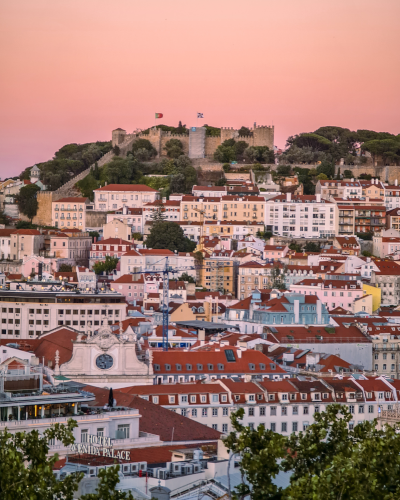
Castelo de São Jorge from Miradouro de São Pedro de Alcântara
Nowadays, Castelo de São Jorge is fully restored and open to the public. You can walk around the grounds of the castle and explore the castle’s ramparts, towers and courtyards. Since the castle is built on top of a hill, you’re greeted with stunning views of Lisbon. There’s also an archaeological center with archaeological ruins and a museum with a collection of objects found in the archaeological site and the castle’s quarter. The ruins and objects in the archaeological center and museum date back to the 7th century BC. We can highly recommend paying a visit to the castle!
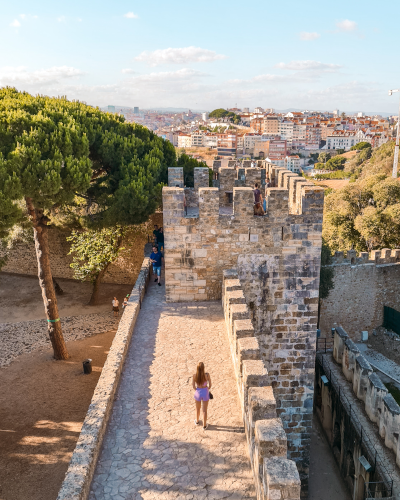
Walking on the castle’s ramparts
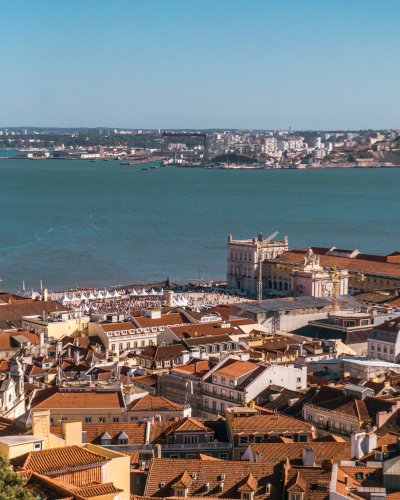
The view from the castle
Opening hours of Castelo de São Jorge
March - October: daily from 09:00 until 21:00
November - February: daily from 09:00 until 19:00
You can buy tickets for Castelo de São Jorgeonline here.
Lisbon Cathedral
Another landmark in the Alfama neighborhood is the Lisbon Cathedral, or Sé de Lisboa. The cathedral was built in 1147 and is the oldest church in the city. Over the centuries, the cathedral has been rebuilt, renovated and restored several times, resulting in a mix of different architectural styles with features from Romanesque, Gothic and Baroque architectural styles. One of the main features of the cathedral is the rose window in the west facade, which dates back to the first building period of the church and has been preserved ever since. You can’t miss it when walking past the cathedral. It’s possible to visit the cathedral and explore the interior. A visit to the cathedral also includes a visit to the High Choir, the Treasury Museum and a walk through the naves and behind the altar of the church.

Lisbon Cathedral
Opening hours of the Lisbon Cathedral
June - October: Monday until Saturday from 09:30 until 19:00
November - May: Monday until Saturday from 10:00 until 18:00
Closed on Sundays and Holy days.
You can buy tickets for the Cathedral online through this link.
Miradouro de Santa Luzia
Miradouro de Santa Luzia is located in the Alfama neighborhood and is by far the most beautiful viewpoint in Lisbon. From up here, you have a beautiful view of the Tagus River, the National Pantheon, and the typical orange roofs of Lisbon. The Miradouro de Santa Luzia is named after the nearby 18th-century church of the same name, which is dedicated to Saint Lucy. What makes this viewpoint unique are the beautiful blue-colored, typically Portuguese tiles, called Azulejos, which depict scenes from Lisbon’s history and traditions. Furthermore, there’s a garden which is filled with bright pink bougainvilleas in spring and summer. The combination of blue Azulejos with the pink bougainvilleas is simply perfect.
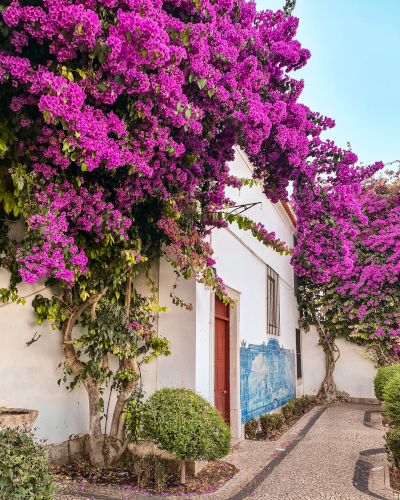
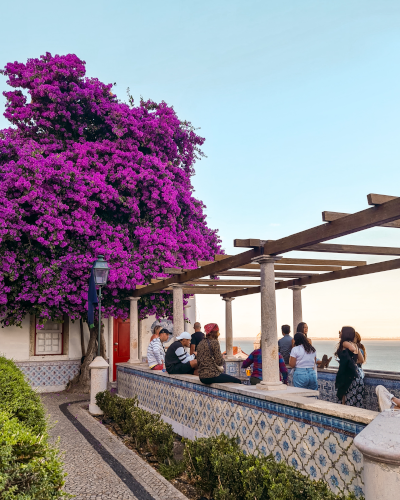
Miradouro de Santa Luzia in the evening
If you ask us, you can’t miss this gorgeous viewpoint in Lisbon. Be aware that this is a very popular spot for tourists as well as locals to relax and enjoy the views. If you’d like to take photos here, you have to come early in the morning.
Day 2
On our second day in the city, we started where we left off the first day: at Miradouro de Santa Luzia. As it was so crowded at the viewpoint the evening before, we decided to go back in the morning to take photos, before venturing onto more sightseeing spots.

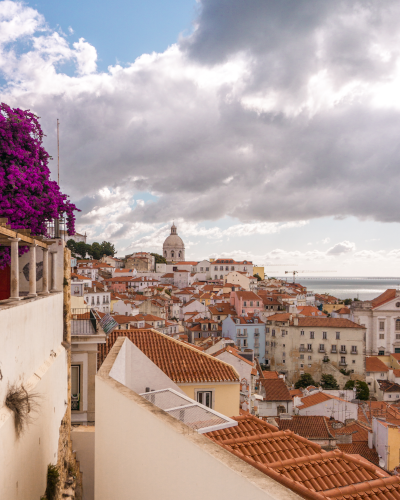
Miradouro de Santa Luzia in the morning
Miradouro de São Pedro de Alcântara
Miradouro de São Pedro de Alcântara is a beautiful and popular viewpoint located in the Bairro Alto neighborhood. From here, you can enjoy panoramic views of the city, including the Castle of São Jorge, the hills of Lisbon and of course the abundance of orange roofs. The viewpoint is near many nice cafes and restaurants. We actually loved the restaurants in the Bairro Alto neighborhood and had dinner here almost every night. Unlike many other viewpoints in Lisbon, this one never seems too crowded despite being a pretty popular viewpoint. This is great for taking photos as you can simply go there any time of the day. Of course, sunrise and sunset would provide the best light conditions to capture the views from here. As we often had dinner near this viewpoint, we were able to capture the sunset light from here as well. Note that you can’t see the actual sunset from here.
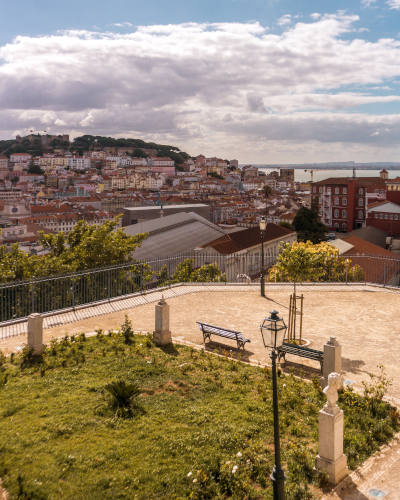
Miradouro de São Pedro de Alcântara during the day
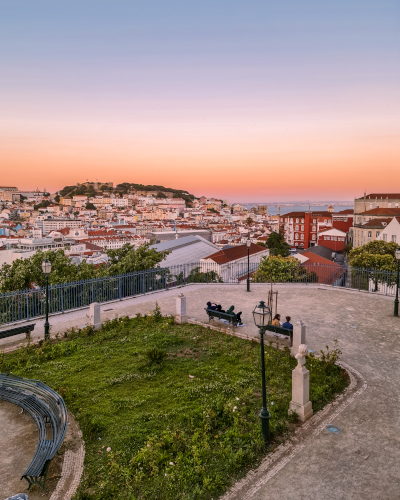
Miradouro de São Pedro de Alcântara during sunset
Trams and funiculars in Lisbon
The trams of Lisbon, also known as elétricos, are an iconic feature of the city’s transportation network and a beloved part of its cultural heritage. Trams have been an integral part of Lisbon’s urban landscape since the late 19th century, and they continue to be a popular mode of transportation for locals and tourists alike. The first tram line in Lisbon was inaugurated in 1873 as a horsecar line. These vehicles were deployed in the flat parts of the city as Lisbon’s slopes were too steep for the horses to get up with passenger loads. For the steep slopes, funiculars were a good alternative of which the first started operating in 1884. For the longer and curved routes of Lisbon’s streets, electric cable trams were a good alternative. The first cable tram line started operating in 1890. In 1959, there were 27 tram lines operating in Lisbon. With the construction of the metro network and the expansion of the bus system, the tram network started to decline. In some parts of the city, the narrow and curved streets can only be crossed by small trams, therefore there are still six of the historical tram lines in operation.

A typical yellow tram in Lisbon
Lisbon’s historic trams and funiculars are easily recognizable by their bright yellow color and vintage design. One of the most famous tram lines in Lisbon is [tram 28][tram 28 tickets]{:target=”_blank”}, which runs from the Graça neighborhood to the Alfama district. The line passes through some of the city’s most picturesque neighborhoods and offers stunning views of Lisbon’s historic architecture and landmarks, including the Castelo de São Jorge and the Sé Cathedral. You can get tickets for tram 28 with an audio guide as well as a day pass for public transportation through this link.
Some of the historical funiculars are also still in operation today. One of the most famous funiculars is Ascensor da Bica, or the Bica Funicular. The Ascensor da Bica runs between Rua de São Paulo and Calçada do Combro and started operating in 1892. We can highly recommend watching the funiculars go by as it’s such a unique experience. We didn’t ride the funicular but we can imagine that being fun too.
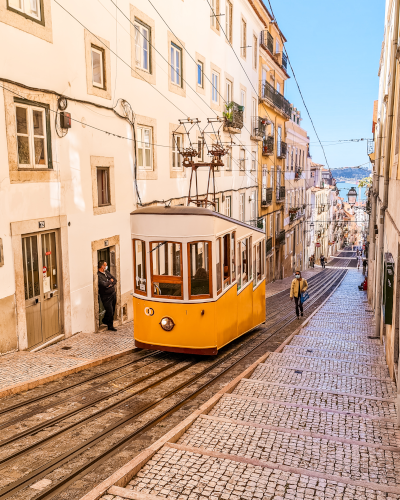
Ascensor da Bica
Rua Nova do Carvalho
Rua Nova do Carvalho, also known as Pink Street, is a street located in Lisbon’s historic neighborhood of Cais do Sodré, which has a fascinating history. This neighborhood was once known as the “Red Light District” of Lisbon. In 2011, the city government launched a revitalization project to transform Cais do Sodré. Old buildings were closed and new cafés, restaurants and clubs were opened. In honor to its past, the street in Rua Nova do Carvalho was painted pink and was nicknamed Pink Street, or Rua-Cor-de-Rosa. Nowadays, this street and its surroundings is the most popular nightlife area in Lisbon.
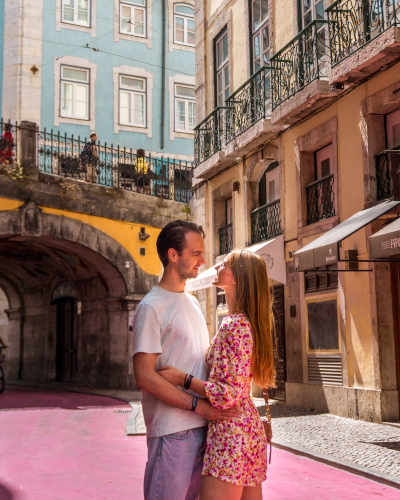
Can you tell why it’s nicknamed Pink Street?
Palácio Quintela
Palácio Quintela is a historic palace located in the heart of the Chiado neighborhood. The palace was built in 1781 as a residence for the family of the Barons of Quintela. The palace is designed in Neoclassical and Neo-Baroque style. For many years, the Palácio Quintela was used as a private residence for members of the Portuguese nobility, and later wealthy businessmen. It was also the site of many lavish parties and social gatherings, hosting some of the most prominent figures in Portuguese society. After years of inactivity, the palace was opened in 2016 as a restaurant and bar under the name Palácio Chiado. The building’s original architectural features have been preserved, including its grand staircase, elegant columns, and ornate ceiling frescoes. We can highly recommend having lunch or dinner in Palácio Chiado as the interior and the food is absolutely worth it. We’d recommend reserving a table in advance through their website. For us, it was a last-minute decision to have lunch here. We showed up right when the restaurant opened and luckily, they were able to get us a table. Please note that this is a chic restaurant so you might want to dress accordingly and be prepared to spend more money than usually in Lisbon.
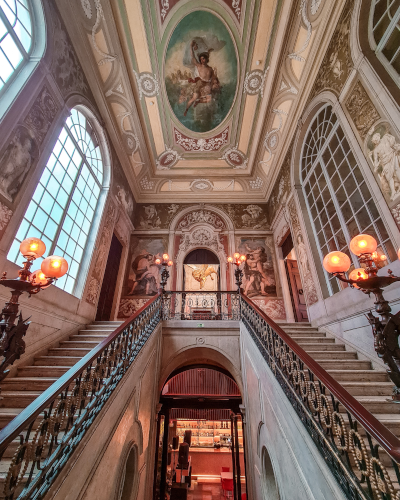
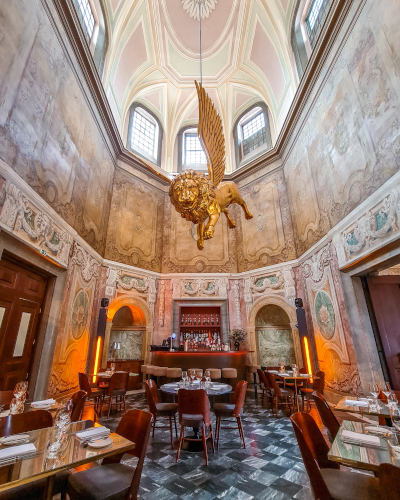
Restaurant Palácio Chiado
Praça do Comércio
Praça do Comércio, also known as Terreiro do Paço, is one of the most iconic and historically significant squares in Lisbon. The square is located along the Tagus River in the Baixa district and it has served as a focal point for trade, government, and culture throughout the centuries. The square formerly housed the Ribeira Palace, which was built in the early 16th century by King Manuel I. The 1755 earthquake, which was followed by a tsunami and a fire, destroyed the Ribeira Palace and other buildings by the river. In the years after the earthquake, Praça do Comércio was built, a large rectangular square in the shape of a “U”, with an opening towards the Tagus River. The surrounding buildings of the square have galleries on the ground floor. At the center of Praça do Comércio stands a statue of King José I, who ruled Portugal in the 18th century.

Gallery on Praça do Comércio
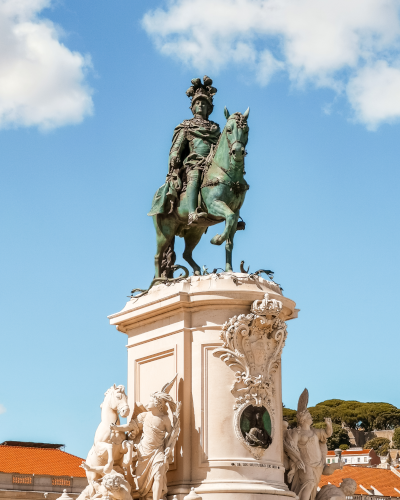
Statue of King José I on Praça do Comércio
Arco da Rua Augusta is a tall memorial arch-like structure, located on Praça do Comércio, connecting the square to Rua Augusta. The arch was constructed between 1755 and 1873 and with its bright white stone, it’s hard to miss. This triumphal arch was built as part of the city’s post-earthquake reconstruction efforts and has since become a symbol of the city’s history and culture. The arch is decorated with statues of historical figures.
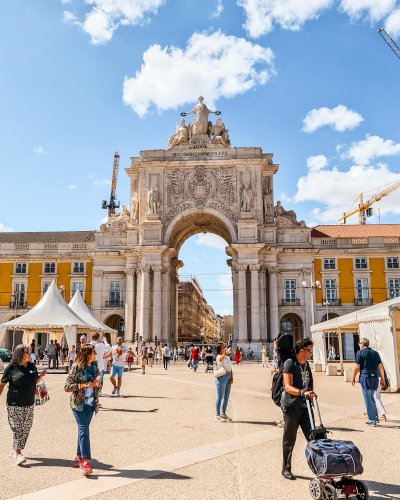
Arco da Rua Augusta
If you’re into shopping, Rua Augusta and the surrounding streets in the Baixa neighborhood are perfect for that. You can also find a lot of bakeries, cafés and restaurants in this area. If you’re planning on eating in the Baixa neighborhood, we’d recommend doing some research in advance as many of the restaurants are tourist traps due to the touristic area.
Praça do Comércio is also the starting point of a bout tour on the Tagus River, which is a great way to explore Lisbon from the water!
Elevador de Santa Justa
The Elevador de Santa Justa, or the Santa Justa Lift, is an iconic elevator located in the historic center, connecting the lower streets of the Baixa neighborhood to the higher Largo do Carmo (Carmo Square). Elevador de Santa Justa is the only remaining vertical lift in Lisbon. The Neo-Gothic iron elevator has been in operation since 1902 and is 45 meters in height, covering seven stories. The elevator fits 35 people and there’s an observation deck on top of the structure, offering beautiful views of the city.

The Santa Justa Lift
Because of the unique experience, Elevador de Santa Justa is very popular with tourists, which can result in long wait times of often around 30 minutes. If you’re like us and you don’t feel like waiting and paying for the experience of going up in a historic elevator, there’s a way to get to the same spot Elevador de Santa Justa takes you that is completely free of charge and has no waiting times. Here’s how to do it. Walk past the elevator towards Rua do Carmo. There you’ll see a store called Oslo with signs for a rooftop bar called Carmo. Take the elevator inside to the top floor.
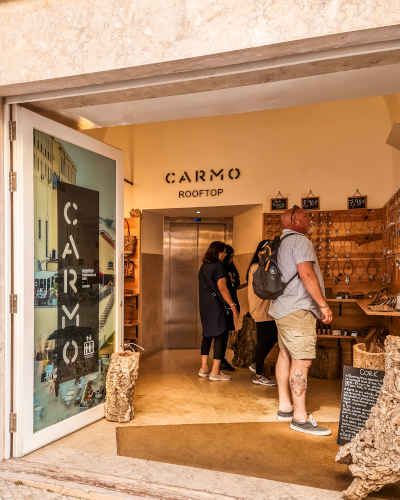
Take this elevator to the top floor
Once you’re out of the elevator, take the stairs up and you’re greeted with beautiful views of the city. You can even enter the walkway of the Elevador de Santa Justa. As you probably already figured, there’s a rooftop bar here with the same amazing views where you can have a drink and/or a bite.
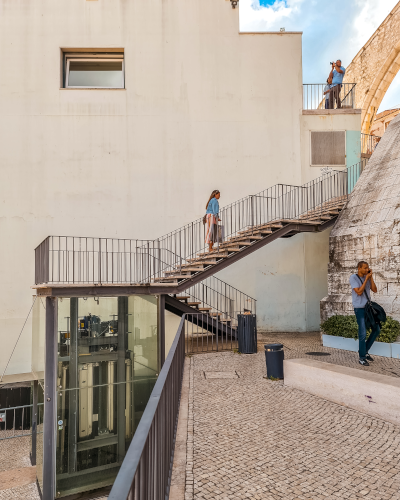
Take these stairs up
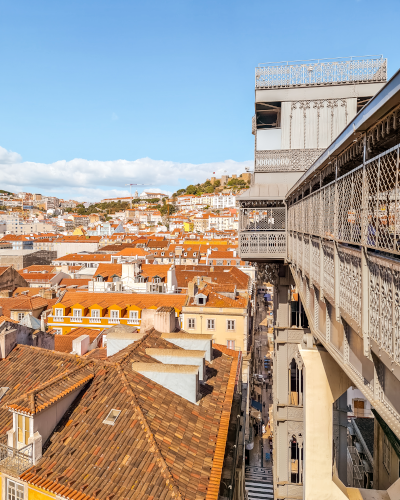
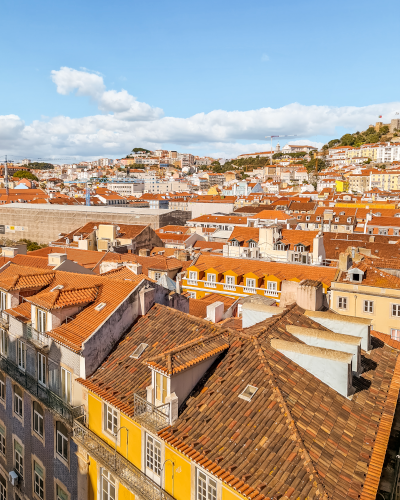
The views from the top of the Santa Justa Lift
Opening hours of the Elevador de Santa Justa
March - October: daily from 07:00 until 23:00
November - February: daily from 07:30 until 21:00
A return ticket for the Elevador de Santa Justa is €5,30. The elevator is part of the public transport system and is included in the 24-hour public transport ticket. The admission fee for the observation deck is €1,50 and is included in the return ticket, but not in the 24-hour public transport ticket.
Opening hours of the Oslo store
Daily: from 10:00 until 19:00
We’re not entirely sure but since the elevator to the rooftop bar is right inside the Oslo store, we think you can only take this elevator during the store’s opening times.
Day 3
On our third day in Lisbon, we ventured out on a day trip to Sintra. Sintra is a town just 30 kilometers west of Lisbon and is known for its stunning palaces and estates that often have lush gardens. As Sintra is well-connected by public transport from Lisbon, we took the train. The train to Sintra leaves from multiple stations in Lisbon and takes around 35 minutes. You might have to take the metro to one of the train stations, depending on where in Lisbon you’re staying.
In Sintra, we visited Pena Palace, Quinta da Regaleira and Monserrate Palace, which are all very beautiful palaces and estates. You can read about our experiences in this blog post in which we share everything you need to know about visiting Sintra. We would highly recommend visiting Sintra on a day trip from Lisbon, or even staying a few days in Sintra. It’s an experience that you can’t miss when in Lisbon.

Pena Palace

Quinta da Regaleira
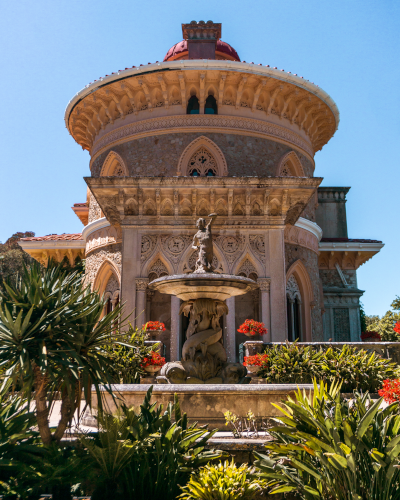
Monserrate Palace
Day 4
We spent the fourth day in Lisbon in the nearby beach town Cascais and Lisbon’s neighborhood Belém. Lisbon is well-connected to Cascais by train, which leaves every 20 minutes from the train station Cais do Sodré, and takes 40 minutes. The neighborhood Belém is connected to this same train line. However, there are also multiple trams and buses connecting Belém to Lisbon’s city center.
Cascais
We didn’t plan too much of our trip to Cascais and simply walked around the historic center and along the coastline. The historic center is small, but filled with beautiful and colorful buildings. As Cascais is a popular seaside destination for both local and international tourists, there are a lot of souvenir stores in the city center.
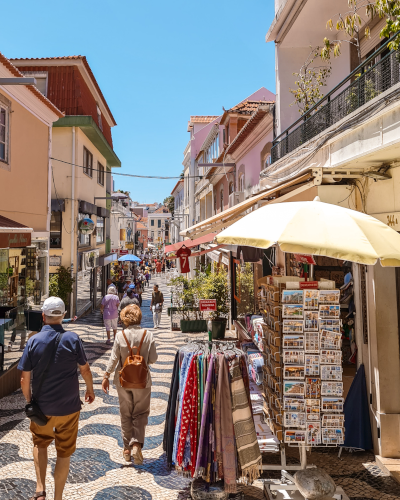
The historic center of Cascais
During the 19th century, Cascais became a popular seaside resort when King Luís I resided in Cascais every summer. This attracted members of the Portuguese nobility, who built grand mansions and villas along the town’s picturesque coastline. We can highly recommend walking along the coastline. You’ll stumble upon some of these beautiful villas and of course Sintra’s beautiful beaches. All beaches have a few beach bars that look nice for a drink or a bite. If you’re staying a few days in Lisbon and would like to spend a day at the beach, Cascais is perfect for that.
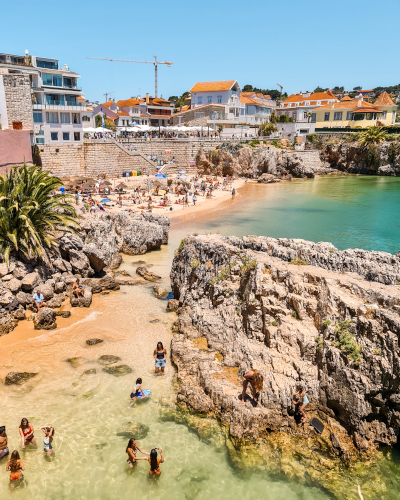
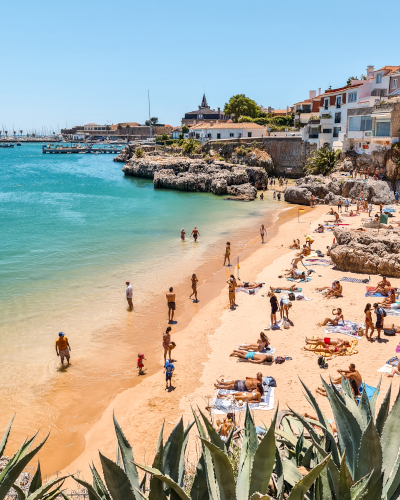
Beaches in Cascais
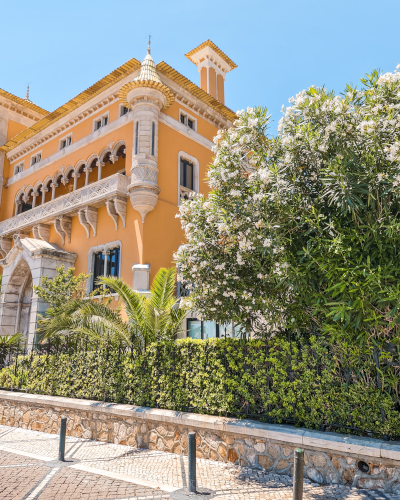
A coastline villa next to an oleander tree
As we didn’t do much research before going to Cascais, we missed out on the Palácio dos Condes de Castro Guimarães, which was built between 1897 and 1900 as an aristocrat’s summer residence and has been a museum since 1931. The residence is beautifully designed in different architectural styles including Neo-romanticism, Neo-Gothic, Neo-Manueline and Neo-Moorish. Telling from the photos of the residence, the interior is well-preserved with intricate details. It looks like we have to save this place for our next trip. You can also visit the nearby Santa Maria Lighthouse and the Casa de Santa Maria.
Opening hours of Palácio dos Condes de Castro Guimarães
Tuesday - Sunday: from 10:00 until 18:00
Closed on Mondays. An entrance ticket is €4.
Opening hours of the Santa Maria Lighthouse
Wednesday - Friday: from 11:00 until 12:00
The admission fee to get up the lighthouse is €2. Plan accordingly if you want to go up the lighthouse as the opening hours are very limited.
Opening hours of the Casa de Santa Maria
Tuesday - Sunday: from 10:00 until 18:00.
Closed on Mondays. An entrance ticket is €5 and includes entrance to the lighthouse museum (not the lighthouse itself).
Belém
Belém is a district of Lisbon and is mostly known for the Belém Tower and the Jerónimos Monastery.
The Belém Tower
The Beélm Tower was constructed between 1514 and 1519, and served as a point of embarkation and disembarkation for Portuguese explorers. At the time, Portugal was a major global power, with colonies and trading posts around the world, and the tower was an important part of the city’s defense system. The tower is predominantly designed in Manueline style, but it also has Moorish architectural influences. In addition to its defensive function, the Belém Tower also served as a gateway to the city, as ships entering the Tagus River had to pass by the tower before reaching Lisbon. The tower was also used as a customs house and a prison at various times throughout its history. Since 1983, the tower has been a UNESCO World Heritage Site. It’s possible to visit the 35 meters high tower and explore the interiors, such as the governor’s chamber, the king’s chamber and the chapel, as well as the tower terrace overlooking Belém and the Tagus River. Even though the view from the top of the tower is probably beautiful, we didn’t go inside the tower as the interior doesn’t look very interesting and it was quite crowded. For us, admiring the tower from outside was enough. There’s a large patch of grass in front of the tower, where you can relax for a bit.
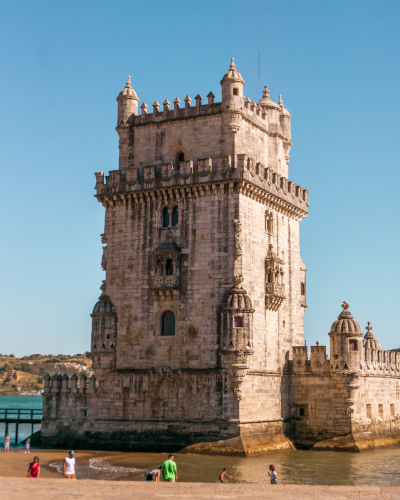
Belém Tower
Opening hours of the Belém Tower
May - September: Tuesday to Sunday from 10:00 until 18:30
October - April: Tuesday to Sunday from 10:00 until 17:30
Closed on Mondays, January 1st, Easter Sunday, May 1st, June 13th and December 25th. An entrance ticket is €6. Entrance is free of charge the first Sunday of every month.
Jeronimos Monastery
The Jeronimos Monastery, also known as the Hieronymites Monastery, is considered one of the most impressive examples of Manueline architecture style, which was characterized by intricate carvings, ornate decorations, and maritime motifs. The construction of the monastery and church started in 1501 and took almost a century. The monastery was occupied by monks of the Hieronymite order who were given the task to pray for the King’s eternal soul and to provide spiritual assistance to navigators and sailors who discovered lands around the world. The monks executed this task for over four centuries until the order dissolved in 1883 and the monastery was abandoned. Just like the Belém Tower, the monastery was designated as a UNESCO World Heritage Site. You can visit the monastery and explore the interior of the monastery. The courtyard especially looks very interesting, which is surrounded by two-storied galleries and arches filled with details. Unfortunately, we didn’t go inside as we were tired so we can’t share our personal experiences. The monastery sure looks impressive from the outside as well.
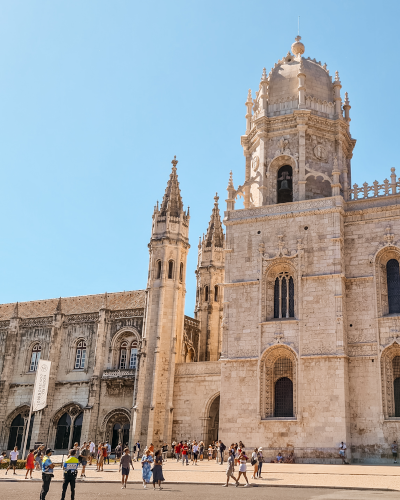
Jeronimos Monastery
Opening hours of the Jeronimos Monastery
May - September: Tuesday to Sunday from 09:30 until 18:00
October - April: Tuesday to Sunday from 09:30 until 17:30
Closed on Mondays, January 1st, Easter Sunday, May 1st and December 25th. An entrance ticket to the monastery is €10. The entrance to the church is free of charge.
Pastéis de Belém
Did you know that the famous Portuguese delicacy pastel de nata originates from Belém? In the late 17th century and 18th century, monasteries used large quantities of egg-whites for starching clothes. Throughout the country, monasteries used the leftover egg yolk to make cakes and pastries, resulting in different local sweet pastry recipes, such as ovos moles in Aveiro. The monks of the Jeronimos Monastery created the pastel de nata, which became the most famous Portuguese delicacy. When the Jeronimos order was dissolved in the 19th century, the monks sold the pastel de nata recipe to a nearby sugar refinery to bring in revenue. The owners of the sugar refinery opened the Fábrica de Pastéis de Belém in 1837, which is still open for business to this date. The original recipe of the pastel de nata has been kept a secret. Fábrica de Pastéis de Belém is just a stone-throw away from the Jeronimos Monastery and is very popular with visitors to Belém. Over 20.000 pastéis de nata are sold every day. Unfortunately, this means that the lines to get a pastel de nata at Fábrica de Pastéis de Belém are insanely long. As the line almost reached all the way to the monastery, we decided to skip this experience. We think it’s best to visit Fábrica de Pastéis de Belém in the morning or in the evening to limit wait times. There are separate lines to take away and dine in. For dining in they offer pastries as well as sandwiches.

We couldn’t get the entire line in frame, but it was very long
Tips for using public transport in Lisbon
When traveling by train or metro in Lisbon for the first time, you will need to purchase a rechargeable paper card for €0.50 from one of the machines located in the stations. After obtaining the card, you must load it with a train or metro ticket. Most stations have gates that can be opened with the rechargeable paper card, while others require validation at a validation pole marked with a sign reading “validate aqui”. A one-way metro ticket costs €1,50, while a return train ticket for Lisbon to Sintra or Cascais costs €4,50. However, it is important to note that the ticket machines may not always function properly. Some may not accept card payments, while others may have stuck coins or experience difficulty accepting euro bills. As a result, it is advisable to bring cash and allocate sufficient time for obtaining a metro or train ticket in Lisbon.
How long to stay in Lisbon
We stayed in Lisbon for 4 days of which we spent one day in Sintra and one day in Cascais and Belém. This means we only had 1,5 days in Lisbon, which was a little short. Even though we were able to visit most of the places we wanted to, it would have been better if we had one or two days extra in Lisbon so we didn’t have to rush things. Especially, if you want to visit some museums in Lisbon, we’d recommend staying longer. A museum that was still on our list which we didn’t have time for was Museu Nacional do Azulejo, a museum dedicated to Azulejos. Lisbon is also home to lots of trendy cafés of which we were only able to visit a few. It’s safe to say that we still have plenty of things to do on our next visit.

The view from Castelo de São Jorge
The best time to visit Lisbon
We visited Lisbon at the end of June, and it was insanely crowded, mostly with American tourists. Usually, European destinations get very crowded during July and August because most European countries have summer vacation in those months. Therefore, we hoped that there would be fewer tourists at the end of June. We can’t imagine what it would be like in July and August when the European tourists also come to Portugal. Even though the weather was very nice, we’d recommend going earlier or later in the year, preferably early spring or late fall.
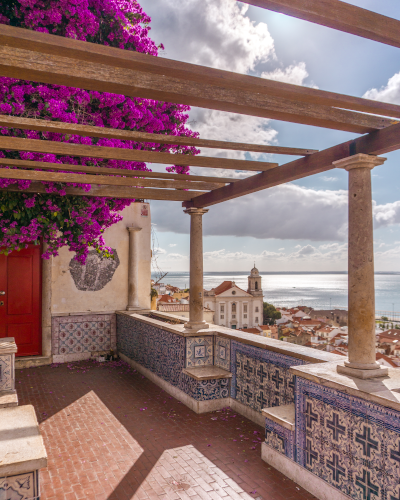
Miradouro de Santa Luzia
Where to stay in Lisbon
As we were traveling to Portugal by car, we looked for a centrally located hotel with a parking garage for a reasonable price. Ibis Lisboa Liberdade ticked off all those boxes. This hotel is located in the neighborhood Príncipe Real, close to the neighborhoods Bairro Alto and Baixa. Both Príncipe Real and Bairro Alto have a lot of trendy cafés and restaurants and we loved these areas for dining. As always with Ibis hotels, the rooms are simple but clean and equipped with everything you need for a few days in the city. The on-site parking garage is accessible by a car elevator, something we had never experienced before.
Click here to book a room in Ibis Lisboa Liberdade.
Click here for more accommodation options in Lisbon.
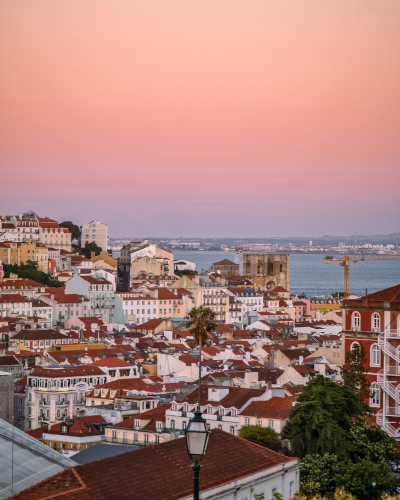
Miradouro de São Pedro de Alcântara
We hope this 4-day itinerary has inspired you to explore the vibrant and historic capital city of Portugal and helped to discover some of the best things to do in Lisbon. Have you been to Lisbon or is it still on your travel bucket list? Let us know in the comments below!
Be sure to check out:
- our online prints store KIPAVISTA.com
- our daily life updates on Instagram
- our YouTube Channel
- our TikTok
More Portugal
Discovering the Best of Aveiro and Costa Nova do Prado
The Most Instagrammable Places in Porto

